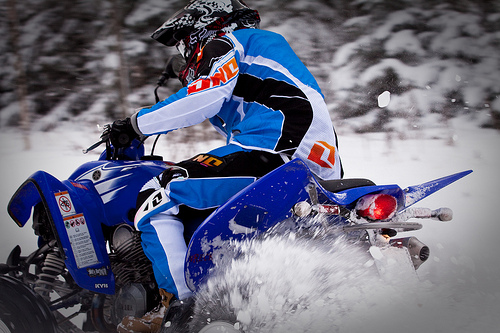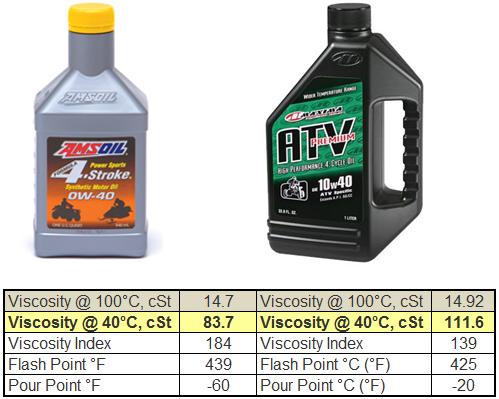Just a little heads up on what’s going on with the motor oil in your ATV’s, UTV’s or motorcycle’s engine and why it’s a good idea to invest in a synthetic oil to get maximum protection in cold climates. As you may know, 90% of the damage done to your bikes motor happens at start-up. The reason is because the motor is not fully lubricated in the starting phase leaving exposed parts to come in contact with other parts of the engine. Further more, it’s not until the oil reaches optimal operating temperature does the oil fully protect the motor.
This is why it is VERY IMPORTANT to always warm up your bike before riding, especially in the winter. It can take 20-30 minutes before oil reaches its optimal operating temp. Does this mean you have to let it sit and idle for 20 minutes before you ride…no. What this means is, don’t fire it up, let it idle for one minute, then go cranking through the field. Instead, while you’re getting suited up, start the bike and let it warm up and then ride at lower RPM’s for 10-15 minutes (depending on how cold the outside temperature is), after that time it’s safe to start running the RPM’s up.
In the winter the bike is sitting in the garage, it’s very cold and what happens to oil when its cold…correct, it gets thicker, it’s harder for the oil to pump through the motor. Because of this scenario it’s best to run synthetic motor oil in your bike because at colder temperatures the synthetic oil is not as thick as conventional oil and it takes less time for the synthetic oil to reach the normal operating temperature that your bike is designed to run at.
Yes, you want the oil to become thinner as fast as possible. Both the conventional oil and synthetic oil (assuming similar grades) operate at the same viscosity when they reach regular operating temperatures. But it’s the synthetic oil that reaches optimal viscosity levels first. In the winter this is extremely beneficial to help protect your ATV’s motor because thick oil makes the bike harder to turn over, it’s hard for the thicker oil to pump through the engine and it takes longer for thick oil to reach all the vital parts of the motor that need lubricated. The longer it takes to completely protect the motor the worse off you are.
Recap:
At colder temperatures (even room temperature) the thickness or viscosity of synthetic oil is less then that of conventional motor oil assuming similar grade motor oils.
Here’s the proof:
As you can see, at 40°C / 104°F Maxima’s conventional ATV motor oil viscosity is (cSt) 111.6 and Amsoil powersports synthetic motor oil is (cSt) 83.7. So the conventional oil is 25% thicker at 40°C / 104°F then that of the similar grade synthetic oil. This percentage gets larger as the temperature of the oil drops, so there would be a significant difference at 0°C / 32°F, which is common in northern states in the winter.
From the screen shot you can also determine what the best viscosity is for your 4-stroke motor at normal operating temperatures which is 100°C / 212°F. By looking at the viscosity rating at 100°C / 212°F for both oils you’ll see just under (cSt) 15 is optimal. This optimal viscosity level was determined by the motor manufactures which work closely with oil manufactures. This shows that both of these similar grade oils are the same thickness at 100°C / 212°F which is a 4-stokes motor oil temp in normal riding conditions. (Racing environments are different, but we’re talking about regular and winter use)
In short, (assuming similar grade motor oils) in cold temperatures conventional oil is much thicker then synthetic motor oil. The goal is to get to viscosity rating (cSt) 15 (rounded) in the shortest time possible to reduce engine wear. It takes 20-30 minutes for the oil to reach optimal operating temperature, so take it easy at first when you start riding to reduce wear.
One more side note, another reason to use synthetic oil in the winter is because conventional oil permanently thickens with exposure to cold climates. Waxes will actually form, reducing the flow rate. When summer rolls back around, if you want to switch back to conventional oil to save some money, it’s OK to switch back over to conventional oil. Contrary to belief, you can switch back and forth as much as you want.
Recommended Synthetic Motor Oil (for ATV, UTV and 4-Stroke Off-Road Motorcycle applications):
Amsoil Formula 4-Stroke PowerSports


